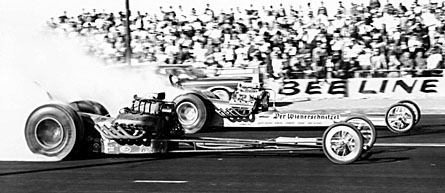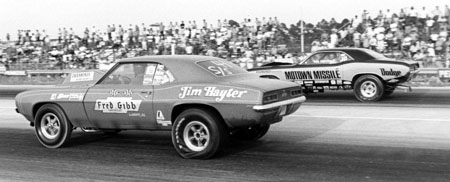|
|
|
|||||
AHRA:
|
||||||
|
- Drag News, Oct. 5, 1956 |
||||||
It might be as corny as Kansas in August, but the old axiom, “From little acorns, do mighty oaks grow,” applies in spades to the American Hot Rod Association's troubled birth and subsequent rise to prominence. AHRA was active for only 28 years, but in that time, the group contributed mightily to what we accept now as modern drag racing, especially modern pro drag racing. Where do you think guys like Don Garlits and John Force earned their stripes initially? Not NHRA. It was in the backroads and outbacks of smaller tracks that made up the AHRA circuit in the midwestern and southwestern reaches of the country in the 1960’s through the early 1980’s. AHRA was responsible for much significant drag racing history. It was
AHRA that first provided a home for Top Fuel, ignoring the fuel ban
of 1957 through 1963, and also giving the Funny Cars their first hot
rod association abode. In fact, while it was not called such, AHRA also
had the first Pro Stock class, a heads-up, ultimate-statement Super
Stock eliminator in 1968.
When AHRA introduced the Grand American Series of Professional Drag Racing in 1970, the sport was given its first year-long points chase that was paid off with a large season-end bonus check. In 1972, Don Garlits teamed with AHRA for the PRA National Challenge event in Tulsa, Okla., a race that ran opposite the sport’s biggest race, the NHRA U.S. Nationals. The Tulsa event, which paid $35,000 to the three pro winners, compared to $5,000 for the NHRA winners, had a revolutionary effect on drag racing presentations and trebled the size of Labor Day race purses the following year. As can be seen, Garlits' name initially gained much luster from his AHRA exploits as did those of Hall of Fame racers like Chris “the Greek” Karamesines, Art Malone, Bob Sullivan, Emery Cook, and Lyle Fisher. While racers like Don “the Snake” Prudhomme, Tom “the Mongoose” McEwen, Danny Ongais and Gene Snow had reputations before their AHRA days, they nonetheless added mightily to them based on their involvement with the Kansas-based organization. And to hammer the point home further, drag racing’s biggest star, John Force, did not achieve his first notoriety with NHRA. In 1984, the last year of AHRA, Force won the organization’s and his first Funny Car world championship. Historically, given what happened outside its walls, if AHRA didn't exist, someone would have had to invent it.
|
||||||
|
Copyright 1999-2001, Drag Racing Online and Racing Net Source |
||||||
 “Constant
headwinds ripping across the Kansas plains with gale proportions of
40 to 50-mph plagued the 200 drivers entered in the American Hot Rod
Association's National Championship drag races at Great Bend over the
Labor Day holidays.”
“Constant
headwinds ripping across the Kansas plains with gale proportions of
40 to 50-mph plagued the 200 drivers entered in the American Hot Rod
Association's National Championship drag races at Great Bend over the
Labor Day holidays.” 
